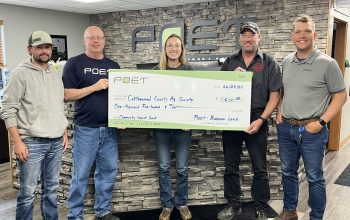Last Wednesday’s informational meeting about the Midwest Carbon Pipeline Express project was one of about 30 that Summit Carbon Solutions, the company responsible for the project, has been required to hold across the state. The Wright County meeting, which took place at Heartland Museum, drew around 200 people and lasted over three hours, most of the time being dedicated to questions from the audience.
The meeting was conducted by the Iowa Utilities Board (IUB), under the direction of board member Josh Byrnes. He explained that such meetings are required by the IUB for all affected counties across the state as part of seeking a permit for what the state considers a “hazardous liquid pipeline.” An attorney for the Office of Consumer Advocate was also at the meeting. Summit Carbons Solutions was represented by three men, James Powell – Chief Operating Officer, Jesse Harris – company spokesman and Jake Ketzner – VP of Government & Public Affairs.
A letter sent to the county by Summit in August describes the pipeline project as follows: The pipeline “will capture carbon dioxide (C02) emissions that otherwise would be emitted into the atmosphere from ethanol plants, including Corn LP in Goldfield, compress the captured emissions, and transport it through a pipeline to North Dakota where it will be permanently and safely stored underground in deep geologic storage locations.”
In addition to Wright County, the proposed project will be located in 29 other Iowa counties plus communities in Minnesota, Nebraska, South Dakota and North Dakota. Summit says the project will be capable of capturing and safely storing up to 12 million tons of C02 emissions every year. The pipeline will cost $4.5 billion. Summit’s goal is to start building in 2023 and be operational in late 2024.
According to the information given out at the meeting, 45.8 miles of the pipeline is proposed to go through Wright County (see map). Both the IUB rep and the Summit reps reiterated multiple times that the route on the map is not final because Summit is not allowed to conduct negotiations with landowners until after the meeting requirement was fulfilled. In other words, they don’t know who is going to let them cross their land with the pipeline yet if the pipeline ultimately goes forward.
The meeting covered many topics including the permit process that Summit must go through and how and when persons affected can file comments or objections to the project. Attendees were provided detailed information on all of these topics and others in a 25-page packet.
A fair amount of time was spent talking about voluntary easements and eminent domain, which are the methods that Summit would use to acquire right-of-way to build the pipeline if the IUB grants them a permit. Summit’s Powell talked extensively about wanting to work with landowners to the benefit of all, including tailoring a path across farm ground that works for the landowner and putting the pipe deeper than the planned 48 inches if necessary.
The Summit officials also had a plan for crop loss and other damages. They propose to pay 100% of crop losses in the first year for the permanent and temporary easement areas, and then 80% and 60% in subsequent years. They also talked about damages due to compaction and disrupting field tile.
After the presentations from the various entities, several questions were asked and statements made. Chris Boshart, GM at Gold-Eagle Coop & Corn LP, spoke up about the need to advance in the ethanol industry and overall promoted the pipeline project. “This project is important to the future of the company. We’re hopeful that it will find a path. Big challenges in the industry require big solutions,” Boshart said.
Several questions were aimed at the safety of the pipeline if it should rupture. Powell from Summit noted that while the concentrated CO2 would dissipate and become a gas in the air, it is indeed an asphyxiant and is therefore life threatening. Other questions involved the pipelines impact on the environment.
Some landowners expressed concern about the depth of the pipeline, 48 inches. They noted that over the years with the changes in the land and erosion that that might not be deep enough. The Summit reps again noted that they are willing to work with landowners on the depth and also noted that they are governed by The Pipeline and Hazardous Materials Safety Administration which is a United States Department of Transportation agency.
The question was also asked why the pipeline cannot avoid most farmland by going down road ditches. To that, Powell briefly said that they plan to follow existing utility corridors. He also noted that they don’t want to disturb highways and roads that much during the process and that county rights-of-way are sometimes so wide, that it would force them into farmland anyway.
There were some skeptics in the crowd. One man accused Summit and the Iowa Utility Board of obscuring the truth and working for profits not people. A group outside the meeting was also handing out anti-pipeline literature.
Overall, the meeting was mostly cordial as landowners listened and sought information. Many questions weren’t fully answered because the path for the pipeline is not set. However, Summit will now be able to enter into negotiations with landowners for easements since the informational meetings are finished.
With the informational meetings complete, Summit now has to wait 30 days before petitioning for a permit. Public hearings will then be held which will be posted in the newspapers of affected areas. These are just the initial steps of many left to come. As IUB board member Byrnes noted, “This is the beginning of a very long process.”
For more information on this process, visit the Iowa Utility Board’s website. To formally file a comment or objection, go to: https://iub.iowa.gov/online-services/open-docket-comment-form


